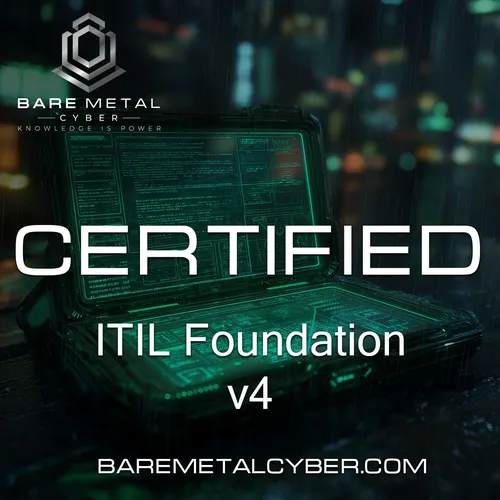
Certified - ITIL Foundation v4 Audio Course
Start your journey into ITIL with this Audio Course — an educational series designed to break down every key concept, from guiding principles to practices, in a way that’s clear, practical, and exam-ready. Each episode delves deeply into the ideas behind modern service management, helping you not only memorize but also truly understand how they apply in real-world contexts. Whether your goal is to strengthen your career skills or prepare with confidence for the ITIL Foundation exam, this series gives you the knowledge and clarity to succeed. Produced by BareMetalCyber.com
- Update frequency
- every day
- Average duration
- 24 minutes
- Episodes
- 58
- Years Active
- 2025

Episode 58: Service Level Management
Service level management ensures that expectations are clear and performance is measured against agreed standards. In this episode, we’ll define how service level management establishes, monitors, an…

Episode 57: Service Desk
The service desk is often described as the “face of IT,” serving as the single point of contact between users and service providers. In this episode, we’ll explain how the service desk practice suppo…

Episode 56: Service Request Management
Service request management is one of the most common and visible practices in ITIL, as it deals with handling user requests in a consistent and efficient way. In this episode, we’ll define service re…

Episode 55: Problem Management
Where incident management is about quick restoration, problem management focuses on addressing the root cause of recurring issues. In this episode, we’ll dive into how problem management identifies u…

Episode 54: Incident Management
Incident management is one of the most visible ITIL practices because it deals directly with restoring services when disruptions occur. In this episode, we’ll explain how the purpose of incident mana…

Episode 53: Change Enablement
Change enablement is one of the most examined practices in ITIL 4, reflecting its importance in balancing agility with stability. In this episode, we’ll explain how change enablement ensures that ris…

Episode 52: Release Management + Continual Improvement
Release management and continual improvement may seem very different, but both play critical roles in keeping services relevant and reliable. Release management ensures that new software, updates, or…

Episode 51: Monitoring & Event Management + Deployment Management
This episode covers two practices that ensure services stay healthy and evolve effectively: monitoring and event management, and deployment management. Monitoring and event management focus on observ…

Episode 50: IT Asset Management + Service Configuration Management
Assets and configurations form the backbone of service delivery, and ITIL provides two practices to manage them. In this episode, we’ll explore IT asset management, which tracks the financial, contra…

Episode 49: Relationship & Supplier Management
Strong relationships are central to successful services, and this episode explores two practices that enable them: relationship management and supplier management. Relationship management ensures tha…

Episode 48: Information Security Management
Information security is a foundational practice in ITIL, ensuring that confidentiality, integrity, and availability of information are protected at all times. In this episode, we’ll explain how the i…

Episode 47: Design & Transition, Obtain/Build, Deliver & Support — End-to-End Flow
The remaining three activities of the service value chain — design and transition, obtain/build, and deliver and support — represent the heart of operational service delivery. In this episode, we’ll …

Episode 46: Engage Activity — Interacting with Stakeholders
The “Engage” activity ensures that all stakeholder needs are understood, communicated, and met throughout the service lifecycle. In this episode, we’ll explore how engagement creates a two-way relati…

Episode 45: Improve Activity — Continual Improvement Mindset
Improvement is not a one-time project but a continuous cycle, and the service value chain embeds this philosophy in the “Improve” activity. In this episode, we’ll explain how the improve activity ens…

Episode 44: Plan Activity — Setting Direction and Goals
The first activity in the service value chain is “Plan,” and in this episode we’ll explain its purpose and relevance. Planning provides a shared vision and direction for all aspects of service manage…

Episode 43: Service Value Chain Overview — Six Activities
At the heart of the SVS is the Service Value Chain, which represents the core activities required to create and manage services. In this episode, we’ll introduce its six activities: plan, improve, en…

Episode 42: Governance, Practices, and Guiding Principles Inside SVS
Governance, practices, and guiding principles are three of the most important elements within the SVS, and in this episode we’ll look at how they function. Governance ensures that policies, decision-…

Episode 41: What is the ITIL Service Value System (SVS)?
The Service Value System, or SVS, is one of the defining innovations of ITIL 4, and this episode introduces it in detail. The SVS provides a holistic model that shows how all the components of ITIL —…

Episode 40: Four Dimensions in Balance — Avoiding Weak Spots
Individually, each dimension is important, but ITIL stresses that they must work in balance. In this episode, we’ll explore how overemphasizing one dimension at the expense of others creates weakness…

Episode 39: Value Streams and Processes — Linking Activities to Results
The fourth dimension brings the focus back to how work is organized and delivered. In this episode, we’ll explain value streams as end-to-end sequences of activities that create value for customers. …